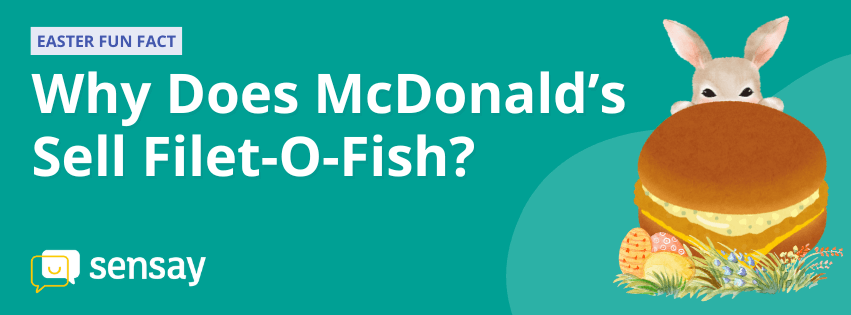Did you know McDonald’s classic Filet-O-Fish was created to meet religious dietary needs?
Back in 1962, a McDonald’s in Cincinnati, Ohio, saw a drop in sales during Lent—when many Catholic customers avoided red meat, especially on Fridays. To address this, store owner Lou Groen came up with a fish burger — the Filet-O-Fish — which quickly became a hit and remains a menu staple today.
Although not exclusive to Easter, the Filet-O-Fish sees a boost in popularity during this season thanks to Lent traditions.
One more fun fact: the Filet-O-Fish originally competed with a meatless option called the “Hula Burger” (a grilled pineapple slice on a bun). Spoiler alert: the fish won.
🐣 Where Did Easter Come From? Origins and 4 Symbolic Traditions
Easter is a major Christian holiday that commemorates the resurrection of Jesus Christ on the third day after his crucifixion. It symbolizes new life and hope, and is typically celebrated on the first Sunday after the full moon following the spring equinox.
The word “Easter” is believed to have originated from Eostre, a pre-Christian Anglo-Saxon goddess of spring and rebirth. As Christianity spread across Europe, many springtime customs merged into Easter celebrations, creating the rich cultural blend we see today.
Here are four of the most iconic Easter symbols:
🥚 Easter Eggs – Symbolize new life and resurrection. Originally dyed red to represent the blood of Christ, they now come in colorful or chocolate versions.
🐰 Easter Bunny – Represents fertility and new life. According to legend, it hides eggs for children to find.
🍞 Blessed Bread – A traditional European food often marked with a cross or lamb symbol, representing sacrifice and rebirth.
🌸 Easter Lily – A symbol of purity and hope, often used in churches during Easter celebrations.
🎓 Teaching Ideas: Celebrate Easter with Sensay
Easter is a great opportunity to bring language, culture, and creativity into your classroom. With Sensay, teachers can design interactive and educational speaking activities for students:
1️⃣ Cultural Introduction|Easter Origins and Symbols
Use images or short texts to introduce Easter’s background and its four key symbols (eggs, bunny, lily, bread). Encourage students to describe them in English using simple sentences like “This is a…” or “I see a…”. Create “reading with images” tasks on Sensay for students to practice speaking with instant AI feedback.
2️⃣ Speaking Practice|Explore Global Easter Traditions
Guide students to talk about how Easter is celebrated around the world using sentences like “In Germany, people…” or “In Italy, they…”. Let them record responses on Sensay and receive personalized AI feedback. We’ve also prepared Easter-themed practice packs to support this!
3️⃣ Interactive Game|Easter Egg Hunt Mission
Create a simple classroom egg hunt using English commands (e.g., “Find the red egg near the window!”) to build listening skills and physical response in a fun, active setting.
4️⃣ Student Sharing|My Easter Experience
Ask students to share what they plan to do or have already done during Easter using future or past tense (e.g., “I will paint eggs.” / “I visited my grandma.”). Turn these into speaking tasks on Sensay to help students practice, revise, and improve with AI support.
#Easter #Sensay #EnglishTeaching #EdTech

